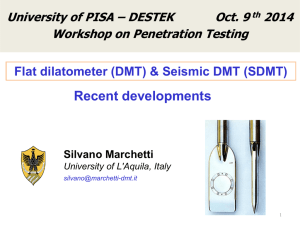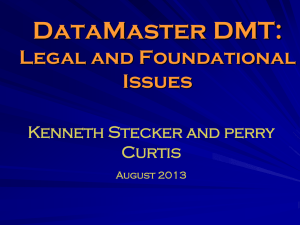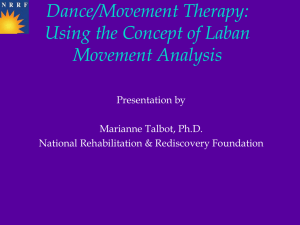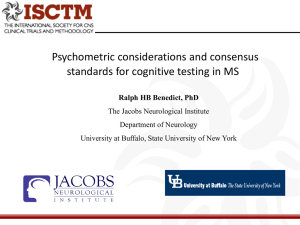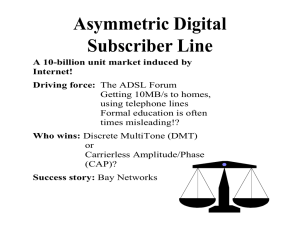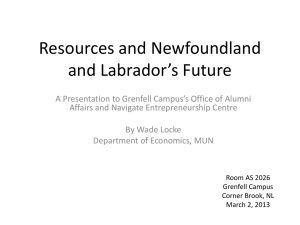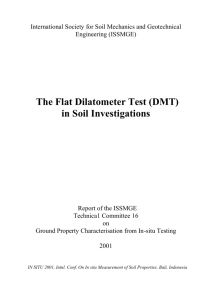DMT
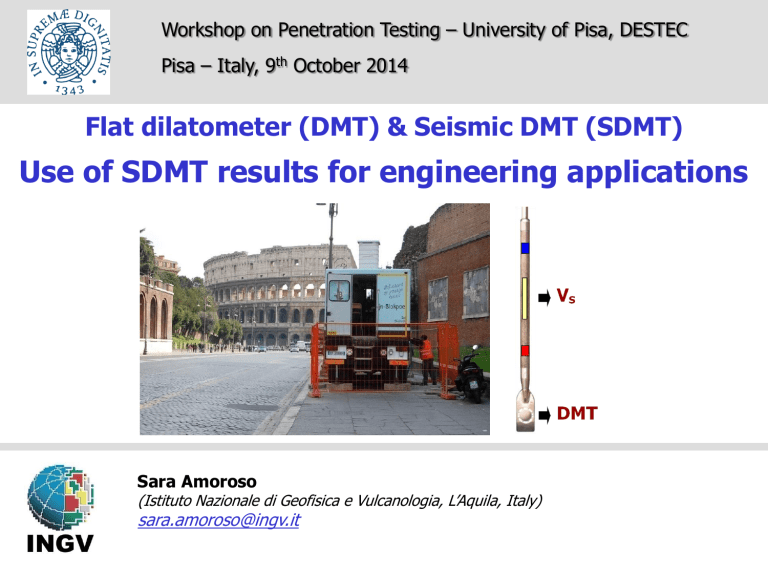
Workshop on Penetration Testing – University of Pisa, DESTEC
Pisa – Italy, 9 th October 2014
Flat dilatometer (DMT) & Seismic DMT (SDMT)
Use of SDMT results for engineering applications
Sara Amoroso
(Istituto Nazionale di Geofisica e Vulcanologia, L’Aquila, Italy) sara.amoroso@ingv.it
Outline of the presentation
1.
Flat dilatometer (DMT)
2.
Seismic dilatometer (SDMT)
3.
Interpretation of the parameters
4.
Engineering applications
Flat dilatometer (DMT) &
Seismic DMT (SDMT)
DMT Flat dilatometer equipment
BLADE
FLEXIBLE
MEMBRANE
(D = 60mm)
DMT Test layout & components
Pneumatic – electric cable
Control box
Push force
Pneumatic cable
Gas tank
Push rods
DMT blade p
0
Lift-off pressure p
1
Pressure for 1.1 mm expansion
Measurements performed after penetration independent from insertion method
DMT insertion with penetrometer
Most efficient method: direct push with penetrometer
DMT Working principle
Sensing disk
(electrically insulated)
Sensing disk
A
B
Blade is like an electrical switch, can be off or on
NO ELECTRONICS no zero drift, no temperature effects
Nothing that the operator can regulate, adjust, manipulate
Retaining Ring
Membrane
DMT Intermediate parameters
DMT Readings Intermediate Parameters
P
0
P
1
Id : Material Index
Kd : Horizontal Stress Index
Ed : Dilatometer Modulus
K
D contains information on stress history
D
M
T
K
D
=
(p
0
- u
0
)
σ’ v formula similar to K
0
: (p
0
– u
0
) σ’ h p
0
K
D is an “amplified” K
0
, because p
0 is an “amplified” σ h due to penetration
Very roughly K
D
≈ 4K
0
E.g. in NC K
0
≈ 0.5 and K
D
≈ 2
K
D well correlated to OCR and K
0
(clay)
DMT Formulae – Interpreted parameters
Intermediate
Parameters
Id
Ed
Kd
Interpreted Parameters
M: Constrained Modulus
Cu: Undrained Shear Strength
Ko: Earth Pressure Coeff (clay)
OCR: Overconsolidation ratio (clay)
: Safe floor friction angle (sand)
: Unit weight and description
K
D correlated to OCR (clay)
OCR = 0.5
K d
1.56
Experimental
Kamei & Iwasaki 1995
Marchetti 1980 (experimental)
Theoretical
Finno 1993
Theoretical
Yu 2004
Cu correlation from OCR
Ladd SHANSEP 77 (SOA TOKYO)
Ladd: best Cu measurement not from TRX UU !!
best Cu from oed OCR Shansep
Cu
σ’ v
OC
=
Cu
σ’ v
NC
OCR m OCR = 0.5
K d
1.56
Using m 0.8 (Ladd 1977) and (Cu/ ’ v
)
NC
0.22 (Mesri 1975)
Cu = 0.22
σ’ v
0.5 K d
1.25
Po and P1
Intermediate parameters
DMT Formulae (1980 – today)
Interpreted parameters
DMT results
I
D
soil type
(clay, silt, sand)
M
Cu
common use
Generally dependable
K
D
= 2 NC clay
K
D
shape similar to OCR helps understand history of deposit
Seismic dilatometer (SDMT)
Seismic Dilatometer (SDMT)
Combination S + DMT
2 receivers
V
S determined from delay arrival of impulse from 1st to 2nd receiver (same hammer blow)
Signal amplified + digitized at depth
V
S measured every 0.5 m
DMT Marchetti 1980
ASTM D6635 – EC7
TC16 2001
SDMT Hepton 1988
Martin & Mayne 1997,1998 ...
Hammer for shear wave
Example seismograms SDMT at Fucino
Delay well conditioned from Cross Correlation coeff of variation of Vs 1-2 %
SDMT results High repeatability
G
O
= ρ Vs 2
DMT Seismic DMT
Vs at National Site FUCINO
–
ITALY
SDMT
(2004)
SCPT
Cross Hole
SASW
AGI (1991)
Fucino-Telespazio
National Research Site
(Italy) 2004
20
Standards
EUROCODE 7 (1997 and 2007). Standard Test Method, European Committee for Standardization, Part 2: Ground investigation and testing, Section 4. Field tests in soil and rock. 4.10. Flat Dilatometer Test (DMT).
ASTM (2002 and 2007). Standard Test Method D6635-01, American Society for
Testing and Materials. The standard test method for performing the Flat
Dilatometer Test (DMT), 14 pp.
TC16 (1997).
“The DMT in soil Investigations”, a report by the ISSMGE
Technical Committee tc16 on Ground Property, Characterization from in-situ testing, 41 pp.
ASTM (2011)
– Standard Test Method D7400 – 08, “Standard Test Methods for
Downhole Seismic Testing
“, 11 pp.
PROTEZIONE CIVILE Gruppo di lavoro (2008) – Indirizzi e criteri per la microzonazione sismica. Prova DMT pp. 391-397, Prova SDMT pp. 397-405
Consiglio Superiore dei Lavori Pubblici (2008)
– Istruzioni per l'applicazione
Norme Tecniche per le Costruzioni NTC08. Circolare 02/02/09 , paragrafo
C6.2.2
Use of SDMT results for engineering applications
Experimental interrelationship between G
0 and M
DMT
SDMT data from 34 sites
● Data points tend to group according to soil type (I
D
)
● G
0
/M
DMT
constant, varies in wide range (≈ 0.5 to
20), especially in clay
● G
0
/M
DMT largely influenced by stress history (K
D
)
● By-product rough estimates of V
S
(when not measured)
Ratio G
0
/ M
DMT vs. K for various soil types
D
(Marchetti et al. 2008, Monaco et al. 2009)
M
DMT
, I
D
, K
D
(DMT) G
0
V
S
Experimental interrelationship between G
0 and M
DMT
COMMENTS
Use of c u
(or N
SPT
) alone as a substitute of V
S
(when not measured) for seismic classification of a site (Eurocode 8) does not appear founded on a firm basis
If V
S classification, then a possible surrogate must be reasonably correlated to V
(M
DMT assumed as primary parameter for site
, I
D
, K
D estimates of V
S
S
… But if 3 parameters
) barely sufficient to obtain rough
, then estimating V parameter appears problematic …
S from only 1
Estimates of V
S from DMT data
Comparison of profiles of V
S
measured by SDMT and estimated from mechanical DMT data (Monaco et al. 2013)
Vs prediction from CPT and DMT
DMT predictions of V
S appear more reliable and consistent than the CPT predictions (Amoroso 2014)
V
S from DMT includes K
D
, sensitive to stress history, prestraining/aging and structure, scarcely detected by q c
Main SDMT applications
Settlements of shallow foundations
Compaction control
Slip surface detection in OC clay
Quantify σ' h relaxation behind a landslide
Laterally loaded piles
Diaphragm walls
FEM input parameters
Liquefiability evaluation
In situ Gγ decay curves
…
Tentative method for deriving in situ
G decay curves from SDMT
SDMT small strain modulus working strain
G modulus
0 from V
G
DMT
S from M
DMT
(track record DMT-predicted vs. measured settlements)
But which associated to G
DMT
?
?
Shear strain "
DMT
"
Quantitative indications by comparing at various test sites and in different soil types SDMT data + “ reference ” stiffness decay curves :
back-figured from the observed behavior under a full-scale test embankment (Treporti) or footings (Texas)
obtained by laboratory tests (L'Aquila, Emilia Romagna, Fucino)
reconstructed by combining different in situ/laboratory techniques
(Western Australia) same-depth "reference" stiffness decay curve
Typical ranges of
DMT in different soil types
"Typical shape"
G/G
0
curves in different soil types
(Amoroso, Monaco, Lehane,
Marchetti – Paper under review)
Range of values of G strain
DMT
DMT
/G
0 and corresponding shear determined by the "intersection" procedure in different soil types
Tentative equation for deriving
G/G
0
curves from SDMT
SDMT data points used to assist construction of hyperbolic equation
G
G
0
1
G
0
G
DMT
1
1
DMT
Roio Piano – L'Aquila
Comparison between
G/G
0
decay curves obtained in Lab and estimated from SDMT by hyperbolic equation
DSDSS (Double Sample Direct
Simple Shear tests): University of Roma La Sapienza
(Amoroso, Monaco, Lehane,
Marchetti – Paper under review)
Validation of in situ G decay curves from SDMT (under study)
Comparison between HSS model – PLAXIS from SDMT parameters and monitoring activities for the excavation of
Verge de Montserrat Station (Barcelona, Spain)
Working group: Amoroso, Arroyo, Gens, Monaco, Di Mariano
35
40
25
30
45
15
20
5
10
Validation of in situ G decay curves from SDMT (under study)
0
0
Oedometric modulus Eoed (MPa)
20 40 60 80 100
HSS model – PLAXIS
Eoed from SDMT (Eoed=Mdmt)
Eoed from HSS model (PLAXIS)
G
0
G
0 ref
1
' p ref
m
Assumptions:
M
DMT
E oed
E
50
E ur
/ 4
1.2
VERGE MONTSERRAT
UG4 Sand
GDMT/G0
Hyperbolic curve
1
0.8
0.6
0.4
G/G
0
= 0.722
0.2
0
1.00E-04 1.00E-03
γ
0.7
1.00E-02 1.00E-01 shear strain, γ (%)
1.00E+00 1.00E+01
Validation of in situ G decay curves from SDMT (under study)
Preliminary results show an acceptable agreement between experimental data (monitoring activities) and numerical analysis (based on SDMT data)
Phase 9
“Pumping down to a depth of 10 m”
-10
Diaphragm wall horizontal movement (mm)
-5 0 5
0
5
10
15
20
25
30
35
40
O BSERVED
N
UMERICAL
A
NALYSIS
10
Concluding remarks
At sites where V
S has not been measured and only mechanical DMT results from past investigations are available, rough estimates of from mechanical DMT data
V
S
(via G
0
) can be obtained
SDMT results could be used to assess the decay of in situ stiffness with strain level and to provide guidance in selecting G curves in various soil types, thanks to its ability to provide both a small strain modulus ( G and a working strain modulus G
DMT derived by usual DMT interpretation)
0 from
(obtained from M
V
DMT
S
)
Use of proposed hyperbolic relationship, which requires to input ratio G estimate of needed)
DMT
G / G
/ G
0
0
+ presumed "typical" shear strain for a given soil type, can provide a useful first order
DMT
curves from SDMT (further validation
